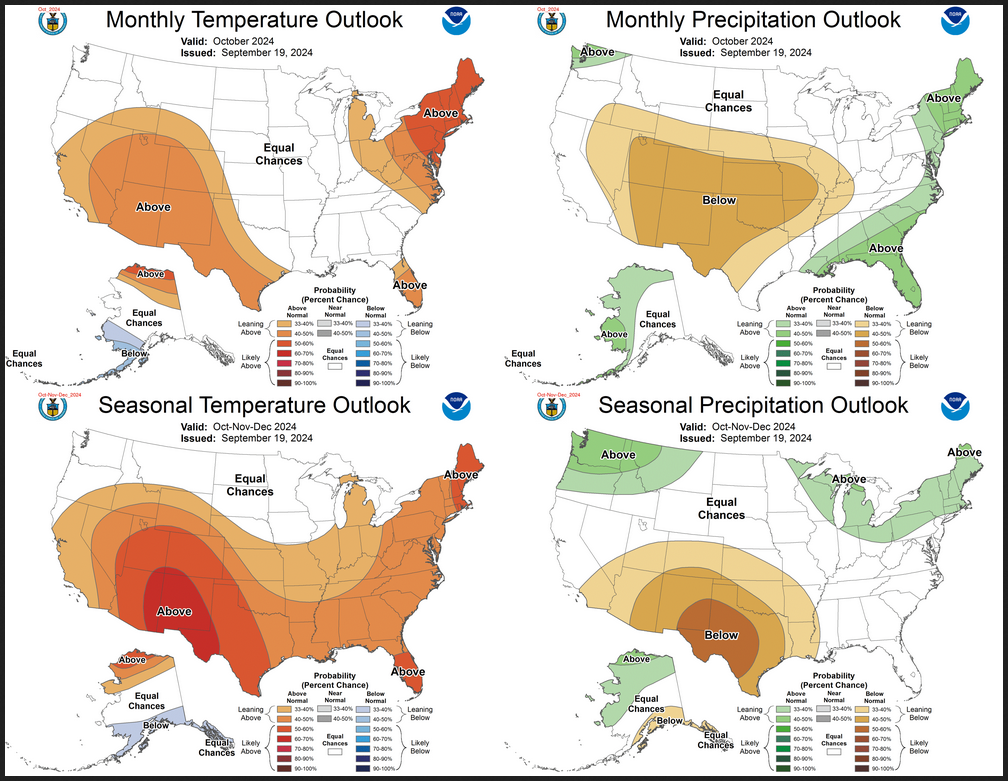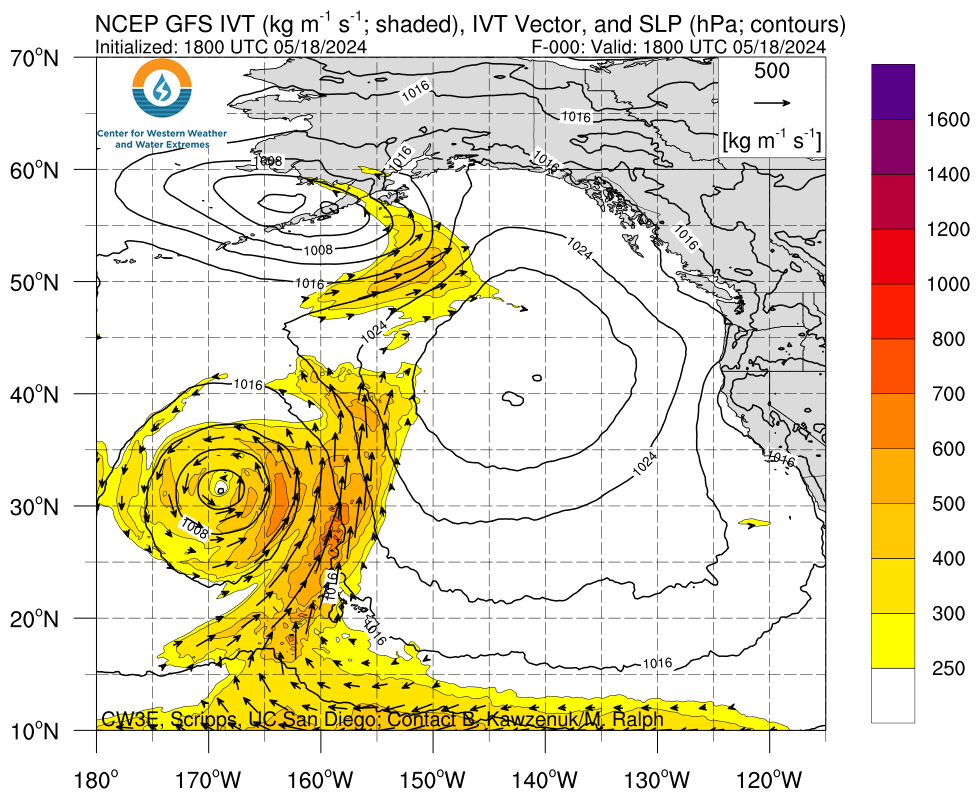This article focuses on what we are paying attention to in the next 48 to 72 hours. The article also includes weather maps for longer-term U.S. outlooks (up to four weeks) and a six-day World weather outlook which can be very useful for travelers.
First the NWS Short Range Forecast. The afternoon NWS text update can be found here after about 4 p.m. New York time but it is unlikely to have changed very much from the morning update. The images in this article automatically update.
Short Range Forecast Discussion
NWS Weather Prediction Center College Park MD
Thu Sep 26 2024
Valid 12Z Thu Sep 26 2024 – 12Z Sat Sep 28 2024…Helene is forecast to rapidly intensify to a major hurricane in the
Gulf today and bring life-threatening impacts to Florida and the Southeast
through Friday……Rare High Risks of excessive rainfall are in place for parts of the
Florida Panhandle where Helene will make landfall, and for the southern
Appalachians where catastrophic flash flooding and landslides are
expected...…Above average temperatures and summer-like warmth forecast to stretch
from the Southwest to northern Plains…Hurricane Helene is moving northward through the Gulf of Mexico this
morning and is forecast to become a major hurricane before making
landfall. Potentially catastrophic hurricane-force winds are expected
within the eyewall of Helene when it makes landfall in the Florida Big
Bend region this evening. Because Helene is becoming a large system and
will initially move inland quickly, damaging and life-threatening
hurricane-force winds, especially in gusts, will penetrate well inland
over portions of northern Florida and southern Georgia late Thursday and
Thursday night where Hurricane Warnings are in effect. Strong wind gusts
are also likely farther north across portions of northern Georgia and the
Carolinas, particularly over the higher terrain of the southern
Appalachians. Additionally, catastrophic and deadly storm surge is likely
along portions of the Florida Big Bend coast, where inundation could reach
as high as 20 feet above ground level, along with destructive waves. There
is also a danger of life-threatening storm surge along the remainder of
the west coast of the Florida Peninsula. Prepare now and heed instructions
from local officials about evacuations in these areas. Please refer to the
National Hurricane Center for the latest updates on the track and timing
of Helene.Helene will also cause significant rainfall and flooding threats. Even
ahead of Helene itself, tropical moisture continues to be pulled north
into the Southeast to southern Appalachians ahead of a slow-moving upper
trough/low and surface front, currently causing rainfall and flooding that
will last through the day. Heavy to extreme rainfall from yesterday has
also led to wet antecedent conditions in places where Helene will track. A
rare High Risk (level 4/4) remains in place in WPC’s Excessive Rainfall
Outlook (ERO) across portions of Georgia into the southern Appalachians
where upslope flow should increase rain totals and varying terrain is
likely to lead to landslides. Additionally, a separate area of extreme
rainfall is also likely near the core of the storm as it passes over the
Florida Panhandle, where a separate High Risk is in effect in the Day 1
ERO. A broad Slight Risk (level 2/4) with an embedded Moderate Risk (level
3/4) over the Appalachians is in place for Friday for continued rainfall.
Overall, Helene is forecast to produce total rain accumulations of 6 to 12
inches, with isolated totals around 20 inches, over portions of the
Southeast into southern Appalachians. Catastrophic and life-threatening
flash and urban flooding, including numerous significant landslides, is
expected across portions of the southern Appalachians through Friday.
Considerable to locally catastrophic flash and urban flooding is likely
for northwestern and northern Florida and the Southeast through Friday.
Widespread significant river flooding and isolated major river flooding
are likely. Another weather hazard associated with Helene to monitor is
the tornado threat, especially on the eastern side of the track. The Storm
Prediction Center is indicating a Slight to Enhanced Risk of severe
weather, primarily for tornadoes, today into tonight for parts of Florida
into Georgia and South Carolina/southeastern North Carolina.Elsewhere, showers and storms are also possible farther north in the
eastern U.S. along the northern part of the frontal system over the next
couple of days. A couple of fronts passing through the Northwest should
lead to some precipitation there and gusty winds. Meanwhile the rest of
the western U.S. stretching into the north-central U.S. can expect dry
conditions with warmer than average temperatures. The Desert Southwest
will see highs well into the 100s and low 110s, which has prompted
Excessive Heat Warnings from south-central Arizona into the high deserts
of southern California. High into the 90s are likely in the northern High
Plains today, with 80s stretching into the Upper Midwest through the end
of the week. Record warm temperatures are possible for both morning lows
and afternoon highs.
To get your local forecast plus active alerts and warnings click HERE and enter your city, state or zip code.
Learn about wave patterns HERE.
Then, looking at the world and of course, the U.S. shows here also. Today we are looking at precipitation.
Please click on “Read More” below to access the full Daily Report issued today.
| Notices: What would you like to learn about? Please provide that to me via the comment section at the end of the article. |
Before we get started on this, I want to include the key graphic from the Updated Four Season Outlook that we discussed HERE yesterday.
The top row is what is now called the Mid-Month Outlook for next month which will be updated at the end of this month. There is a temperature map and a precipitation map. The second row is a three-month outlook that includes next month.
Now more detail on the 48-Hour Forecast (It is a 48 to 72 Hour Forecast actually)
Daily weather maps. The Day 1 map updates twice a day and the Day 2 and 3 maps update only once a day. These maps update automatically. But if that does not happen, you can get updates by clicking HERE
TODAY (or late in the day the evening/overnight map will appear) (Key to surface fronts shown on maps and you will then also be able to insert a city name or zip code and get a local NWS forecast).
TOMORROW
NEXT DAY
We have a new animation of the forecast which shows how things may play out over the next 60 hours. To update click ANIMATION. Doing so will get you to the dashboard. You can then step through the animation or hit LOOP on the upper right of the display. You will have to hit the back arrow ← at the top left on your computer to get back into this article. It is a little more trouble than before but I think NOAA scrapped the animation routine I was using so we have to keep up with “progress”.
The NWS Climate Prediction Center’s: Watches, Warnings, and Advisories plus other information can be found HERE. That takes you to the NWC Severe Weather Site. From there you can select among many categories of information. Remember to hit the back arrow ← at the top left of your screen to return to this article.
ATMOSPHERIC RIVERS
This tells us what is approaching the West Coast. Click HERE to update If I have not gotten around to doing the update. Here is some useful information about Atmospheric Rivers.
Below is the current five-day cumulative forecast of precipitation (Updates can be found HERE)

Ski SnowReports will Resume in the Fall.
Now we look at Intermediate-Term “Outlook” maps for three time periods. Days 6 – 10, Days 8 – 14, and Weeks 3 and 4. An outlook differs from a forecast based on how NOAA uses these terms in that an “outlook” presents information as deviation from normal and the likelihood of these deviations.
Below are the links to obtain updates and additional information. They are particularly useful if you happen to be reading this article significantly later than when it was published. I always try to provide readers with the source of the information in my articles. These links may also be useful for those viewing this article on a cell phone or other small screen.
| Days 6 – 10 (shown in Row 1) | Days 8 – 14 (Shown in Row 2) | Weeks 3 and 4 (Shown in Row 3 but updates only on Fridays) |
| https://www.cpc.ncep.noaa. gov/products/predictions/610day/ | https://www.cpc.ncep .noaa.gov/products/predictions/814day/ | https://www.cpc.ncep.noaa.gov/products/predictions/WK34/ |
Showing the actual maps. They should now update automatically. The Week 3 – 4 Outlook only updates on Fridays. So below is what I call the Intermediate-term outlook. On Fridays, it extends out 28 Days. That declines day by day so on Thursday it only looks out 22 days until the next day when the Week 3 – 4 Outlook is updated and this extends the outlook by one additional week.
| 6–
10
|
|
|
| 8–
14 |
|
|
| 3–
4 |
|
|
HAZARDS OUTLOOKS
Click here for the latest complete Day 3 -7 Hazards forecast which updates only on weekdays. Once a week probably Monday or Tuesday I will update the images. I provided the link for readers to get daily updates on weekdays. Use your own judgment to decide if you need to update these images. I update almost all the images Friday Night for the weekend edition of this Weather Report. So normally readers do not need to update these images but if the weather is changing quickly you may want to.

Temperature month to date can be found at https://hprcc.unl.edu/products/maps/acis/MonthTDeptUS.png
Precipitation month to date can be found at https://hprcc.unl.edu/products/maps/acis /MonthPNormUS.png
World Forecast [that website is has been intermittent so be patient]
Below are the Day 1 -3 and 4-6 forecasts for temperature and precipitation. Updates and much additional information can be obtained HERE
World Temperature Anomalies


World Accumulated Precipitation


This information is provided by the University of Maine. They draw upon many different sources. There is a lot of information available at the link provided. I have just provided two useful forecasts. There are probably over a hundred different forecasts available from this source.
Worldwide Tropical Forecast (This is a NOAA Product)
This graphic updates on Tuesdays) If it has not been updated, you can get the update by clicking here Readers will only have to do that if they are reading this article much later than the date of it being published.
Information on Tropical Storms can be found HERE. Western Pacific information can be found HERE. Note that unless there is an out-of-season storm the below images will not update until the National Hurricane Center starts their seasonal update of these maps on June 1. I include them simply because there can be an out-of-season event in which case it should show up in these maps.


–
| I hope you found this article interesting and useful. |











